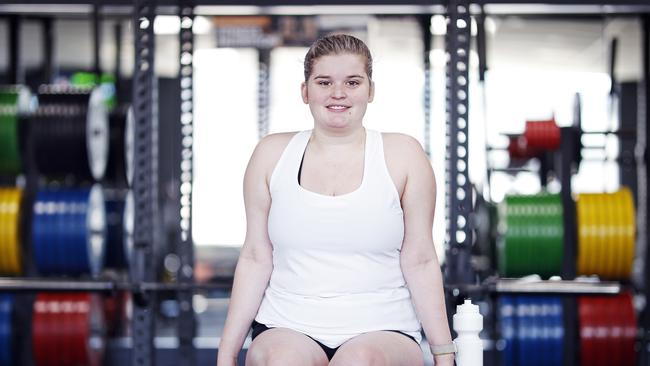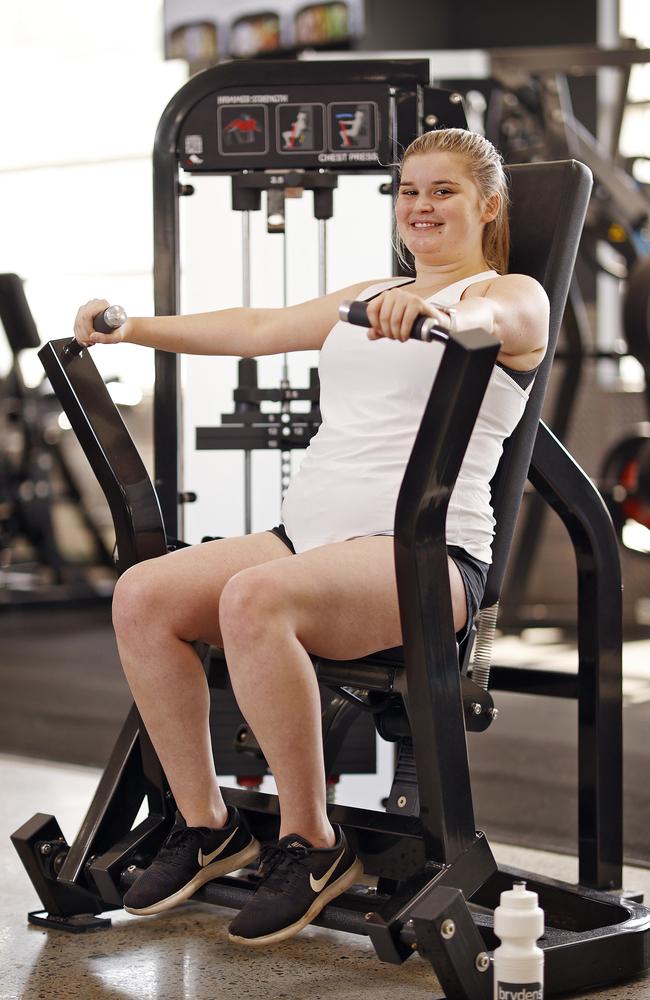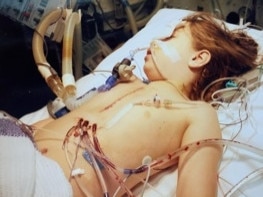Change of heart for brave ‘Zipper kids’ as new study turns traditional thinking on its head
Heart patients first told to safeguard their heart and avoid overtaxing it with exercise are part of a study turning that theory on its head … and paying health dividends.

NSW
Don't miss out on the headlines from NSW. Followed categories will be added to My News.
They’re the zipper kids that were told they couldn’t exercise growing up – but today, a revolutionary new study is seeing them run, ride bikes and lift weights – things they never dreamt would be possible. And it’s having a powerful effect.
Five Dock 21-year-old Annabel Turner was only two hours old when she had her first heart surgery and by the time she turned five had endured 23 heart operations. Campbelltown 26-year-old Sarah West was a member of the zipper club at eight and was always fearful of exercise so not to put a strain on her heart. She can now leg press 170 kilos.
“It’s given me so much more confidence in my ability and showed I can do things I wouldn’t have ever tried before – and I’ve learned a lot about myself doing it,” West, who has recently finished university, told Saturday Extra.
The two women are part of some Australians aged between 10 and 55 years being recruited for the study on exercise theory, which will be the largest ever randomised controlled trial in this cohort.

The world-first study is investigating the role of exercise for congenital heart disease, with early results showing it could drastically improve both lives, and life expectancy.
Heart Research Institute Senior Exercise Physiologist and Co-ordinator of the Congenital Heart Fitness Intervention Trial (CH-FIT), Derek Tran, said until recently, people born with half a heart or single-ventricle congenital heart disease, or Fontan-CHD, were told not to exercise for fear of putting too much strain on their heart.
Researchers are determined to work out whether the very thing patients were warned off could be the key to improving their life expectancy.
“The CH-FIT exercise program will look at whether aerobic and resistance training can improve heart function, lung growth, fitness, and ultimately life expectancy for people with congenital heart disease,” Dr Tran said.
CONFIDENCE TO EXERCISE ALONE
“We want to see if improving fitness is a key marker to an improvement in quality of life. It’s also about giving people the confidence of knowing they can exercise on their own.”
Participants like Sarah and Annabelle initially undertake 60 minutes of low to moderate intensity cardio three times a week, which increases over the four-month program. They work in either small groups or one-on-one with HRI personal trainers in local Fitness First or Club Lime gyms. Those in regional areas will use a combination of a telehealth service and a tailored exercise program at home, while researchers carefully study the impact exercise has on their physical and psychological wellbeing.
Born with CHD, Annabel had 23 heart operations before her fifth birthday and was forced to give up competitive swimming as a teenager, due to the strain of training on her heart. Growing up she avoided team sports and could never go to the gym with her friends, until now. She says nine months into the CH-FIT trial her life has changed for the better, with new confidence in her fitness ability as she prepares for her career as a Town Planner, who will spend a lot of time on building sites.

“I guess one of the positives is my last operation was when I was four and a half, so I don’t I don’t remember the operations – but I do remember as a kid getting tired and not having a lot of energy like the other kids,” she said.
“Now I feel quite good.
“Growing up my cardiologist appointments were every three months from the ages of four to eight, band then it was every six months until I was about 12, then it was every 12 months until I was 18 – now it’s every 18 months.
“So I guess it stresses me out when I have to get a lot of new tests, because I’m always like, well, what if something is wrong?”
As a youngster, Annabel was into competitive swimming, and was told to stop when she turned 10 because of the strain.
“I wasn’t allowed to put that much energy into activity, because it would have been pushing myself too much, so I always had this idea that I couldn’t push myself hard when I was working out or doing anything, because I just would get too tired,” she said.
“Whereas this study has shown me that I can do a lot more than I would have thought.
“Before, if I was on the exercise bike I would have thought I couldn’t do that for 20 minutes – but now I can do that with intensity of eight as a part of this trial.
“If other people who have heart conditions similar to mine, if they were doing this, maybe they could do a lot more than they would have thought too.
“Whereas a cardiologist tell us what we can’t do – they don’t really tell us what we can do.
“It’s up to them if they feel like they can do it – because if you don’t feel like you can do it, you’re not going to try.
“It’s helping me in other ways too, I sleep a lot better at night.

SARAH’S STORY
Sarah West had open heart surgery as an eight-year-old, after being born with a rare congenital heart defect known as Double outlet right ventricle (DORV), where the heart’s two major arteries, the pulmonary artery and the aorta, were both connected to the right ventricle. Sarah says growing up there were also limitations on playing sports at school, and as part of the trial, she’s built up her fitness to the point of four gym sessions a week, no longer requiring the supervision of an exercise physiologist.
“I’m feeling pretty good – there’s definitely a lot more information that’s coming out now, so I’ve been quite blessed because I haven’t been sick or anything, so I’m feeling pretty positive about life, and my condition,” she said.
“When I was younger, I didn’t really want to bring it up again after surgery, I didn’t really feel like I wanted to keep talking about it, so I kept it quite personal and to myself.
“It took a few years to get used to having the scar – but it was towards high school when I thought, people are going to ask about it, and I’ll answer them.”
West said with a good support network, her condition hasn’t stopped her from travelling, exploring the world or finishing university doing something she loves. Now, she can add exercise to that list of achievements.

“Previously I was only told I could do light weight exercises … so having a program where I’ve actually been able to progress to much bigger weights than I’ve ever anticipated doing, I think has definitely given me more confidence in my abilities.
“I mean, I’ve been able to leg press over 170 kilos – my arms are pretty weak, but my legs are quite strong – and I think that’s what I noticed about this trial – I was much stronger than I anticipated.
“I’ve been surprised, and it’s been quite positive for me, so hopefully, it’ll be quite positive for other people too.”
Dr Tran said the benefits of exercise to the general population are widely known, but it’s not known what effect exercise can have on those with CHD.
“We know that regular exercise provides systemic benefits beyond the heart, to the whole body, including bone density, improving cognition and mental health,” he said.
“We also know that people with CHD are at an increased risk of comorbidities and chronic diseases because, for one reason or another, they’ve been sedentary for much of their lives.”
Leading HRI cardiologist Associate Professor Rachael Cordina said emerging research suggests exercising could be more important for people with even the most complex types of CHD, because it has special effects on the circulation.
“People living with half a heart have no heart pump to push blood up through the lungs, so they rely heavily on the exercising muscles in the body – but there is hardly any research to understand the true impact of exercise on these special circulations and how to safely implement exercise training,” Assoc Prof Cordina said.
“Historically, people with CHD were not expected to survive to adulthood, and exercise was discouraged fearing too much stress on the heart.
“A whole generation of children has grown up consciously not exercising, putting themselves at risk of obesity through their inactivity.
“Some have developed into adults who are very unfit and don’t meet anywhere near the physical activity recommendations for the general population.”
Assoc Prof Cordina said the research will help experts develop clearly defined models of care to improve and hopefully lengthen the lives of this group of young people who have often had incredibly challenging life journeys.
There are 1,600 people living with Fontan-CHD – or ‘half a heart’ – in Australia and New Zealand and over 100,000 living with other types of complex CHD. Assoc Prof Cordina said the research gave families and young people with CHD hope.
“It’s a hope for a bright future that we just didn’t have in the past, and I think that’s the most empowering thing science can do,” she said.
The trial is set to expand to patients in Brisbane and Perth.



